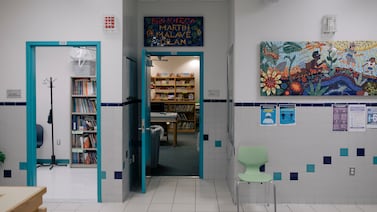Sign up for Chalkbeat Indiana’s free daily newsletter to keep up with Indianapolis Public Schools and statewide education news.
Indiana has joined a growing number of states that require schools to use curriculum materials that emphasize phonetic instruction when teaching children how to read.
A new state law, which passed with bipartisan support and was signed by Gov. Eric Holcomb on May 4, requires school districts to adopt a curriculum that’s aligned with what’s commonly called the science of reading.
Districts are also forbidden from adopting curriculum that relies primarily on using context clues and pictures for literacy instruction, an approach known as the three-cueing model. In addition, teachers licensed after June 2025 to teach a content area involving literacy instruction in prekindergarten through fifth grade must earn a new literacy endorsement to prove they are proficient in the science of reading standards.
The new law comes amid concern from lawmakers and education officials in Indiana and nationwide about elementary school students’ reading ability — an issue exacerbated by the pandemic. Indiana Secretary of Education Katie Jenner said last year that literacy instruction and the use of phonics varies from classroom to classroom. Elsewhere, New York City recently required elementary schools to adopt a phonics-based reading program, and Illinois advocates said students there have struggled to read because schools haven’t relied on the science of reading.
Below, we break down how Indiana defines the science of reading, what the new law actually says, and what it all means for students, teachers, and schools.
What is the science of reading?
The new state statute defines the science of reading as a “vast, interdisciplinary body of scientifically based research” that requires the “explicit, systematic” use of five elements in literacy instruction: phonemic awareness, phonics, fluency, vocabulary, and comprehension.
Phonemic awareness means being able to understand that different sounds form words, said Brandon Sherman, a research project manager in the Indiana University-Purdue University Indianapolis School of Education. Phonics is the ability to break down that word into its different phonemes, or sounds.
State law defines “science of reading” as research that also has a record of success and increases competency in those five elements, as well as oral language skills, writing, and spelling. The research also informs how proficient reading and writing develop, why some students may have difficulty with reading, and how to effectively teach reading to all students.
But the term itself has different meanings to different people, Sherman said.
Do Indiana students struggle with reading?
Just 33% of Indiana’s fourth graders were proficient in reading on the National Assessment of Educational Progress last year, while 31% of eighth graders were proficient in reading. Those scores were roughly in line with the national average. Eighth grade reading scores dropped from their pre-pandemic level in 2019, although the fourth grade scores were statistically about the same as in 2019.
Last year, 81.6% of third graders were proficient on the state’s IREAD exam in 2019; schools may hold back students who don’t pass the test. That’s a decline from pre-pandemic scores. In 2019, for example, 87.3% of students were proficient on the IREAD.
But many students of color have scored much lower on the IREAD than the statewide average. In Indiana, 64.1% of Black students and 69.6% of Hispanic students were proficient on the 2022 IREAD.
What does Indiana’s science of reading law do?
The law requires school districts and charter schools to adopt curriculum or supplemental materials that are aligned with the science of reading by the 2024-25 school year. The state board of education must also develop academic standards for reading based on the science of reading by 2024-25.
It forbids districts from adopting curriculum that is primarily based using context, pictures, or syntax clues to teach students to read.
The law also requires teachers who teach literacy in pre-kindergarten through fifth grade to receive a literacy endorsement through the state if they receive their teaching license after June 30, 2025. School districts are required to offer extra pay for teachers who have the literacy endorsement. The amount of additional pay is up to the district.
The endorsement requires 80 hours of professional development aligned with the science of reading, plus a written exam to demonstrate that educators are proficient in “scientifically based reading instruction skills.”
The state board will adopt the exam, and will establish the procedure for current teachers who wish to add the literacy endorsement to their license.
Teacher preparation programs in Indiana must also use a curriculum that instructs teaching candidates on the science of reading by July 2024. The state education department will develop guidelines for this requirement, and will conduct a review of all accredited teacher programs to ensure the programs adhere to this requirement.
What will change about students’ reading lessons?
This depends on the district.
For example, some districts reported using a curriculum that aligns with the Orton-Gillingham approach, which has systematic lessons on phonics, according to its website.
Others report using the Into Reading curriculum by HMH, which lists phonemic awareness, phonics, fluency, vocabulary and comprehension as among the components of reading instruction.
The state education department will provide a list of curriculums that are based on the science of reading for districts to consider when reviewing whether their current curriculum complies with the law.
In Marion County, a spokesperson for the Metropolitan School District of Wayne Township says it does not believe it needs to change its curriculum, which includes the Heggerty Phonemic Awareness Curriculum, but is awaiting state education department guidance.
Perry Township, which uses the HMH Into Reading curriculum, said its own investigation concluded that all components of science of reading were heavily supported in the curriculum, although there was less use of phonemic awareness in grades 3-5.
“We have reinforced this area through additional training of our teachers in Orton-Gillingham and through the focus of The Science of Reading components during our Professional Development (cluster) time,” a Perry Township spokesperson said in a statement.
The Metropolitan School District of Pike Township did not specify which curriculum the district uses, but said it provided K-2 educators the opportunity to participate in training in LETRS, a professional development tool that says it is based on the science of reading on its website. A spokesperson said the district will provide professional development to ensure its curriculum aligns with science of reading principles.
“When we go through our next curriculum adoption process, we will intentionally select materials that meet the needs of our learners, while adhering to all IDOE [Indiana Department of Education] criteria,” a Pike Township spokesperson said in a statement.
Will Indiana provide new funding for science of reading and literacy?
The state’s biennial budget for 2024-25 allows up to $20 million to fund science of reading initiatives from the state education department each year.
The department can distribute this money to districts for literacy coaches to train teachers in the science of reading, or to use for efforts that increase instructional time, such as summer literacy programs or high-dosage tutoring for struggling readers. Districts can also use this funding to cover the cost of teachers to obtain the new literacy endorsement.
The state’s budget also provides up to $10 million each fiscal year for literacy achievement grants to school districts and charter schools.
This funding is in addition to the $111 million the state announced it would use to train teachers in the science of reading last year.
What’s driven recent interest in literacy instruction?
The so-called “reading wars” over the best approach to teaching literacy date back to at least the 1920s, Sherman said. Some researchers say the debate in the U.S. originated more than 200 years ago.
But the issue became more prominent in recent years due to reporting by American Public Media about school districts’ use of disproven methods of literacy instruction; its coverage of literacy includes the “Sold a Story” podcast. Mississippi also brought attention to the science of reading after embracing the approach and increasing its reading scores in a turnaround effort deemed “the Mississippi miracle.”
The reemergence of literacy instruction as a major issue has also highlighted disagreements between supporters of different teaching methods. For example, researchers and advocates frequently contrast the science of reading with “whole language” instruction, which emphasizes contextual clues to help students learn to read.
Sherman says that historically in the U.S., the popularity of different instructional methods for literacy has waxed and waned.
“We see that again focusing on systematic phonics is the emphasis,” he said. “And then the pendulum kind of goes the other way. And this is where we see whole language. And then the pendulum goes again and we see phonics come back in.”
Amelia Pak-Harvey covers Indianapolis and Marion County schools for Chalkbeat Indiana. Contact Amelia at apak-harvey@chalkbeat.org.





